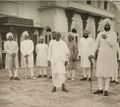Jind
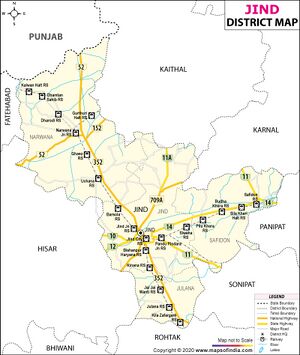
Jind (जींद) is town and district headquarters in Haryana. Other smaller towns are Narwana, Safidon and Uchana in this district. Famous village Sudkain Kalan is also in Jind district . The total area of Jind district is 2736 sq kms and its population is 9,63,000. Ancient name of Jind was Jayanti (जयंती).[1]
Variants
- Jhind (झींद)
Origin of name
Mention by Panini
Jihnu (जिहनु) is mentioned by Panini in Ashtadhyayi. [4]
List of Jind Rulers
- Here is the List of Jind Rulers, click the name to see details.
- Chuadhari Phul Singh (b.-d.1652)
- Tiloka (b.-d.1687)
- Sukhchain (b.1676-d.1751)
- Alam Singh of Jind (b.-d.1764)
- Bulaki Singh (b.- d.)
- Raja Gajpat Singh (b.1738-d.1789)
- Raja Bhag Singh (b.-d.1819)
- Raja Fateh Singh (b.1792 - d. 3 Feb 1822)
- Raja Bhup Singh (b.-d.1815)
- Raja Karam Singh (b.-d.1818)
- Raja Sangat Singh (r.30/7/1822-d.)
- Raja Sarup Singh (r.1837-d.26 Jan 1864)
- Raja Raghuvir Singh (r.31 March 1864-d.1887)
- Raja Ranvir Singh (1879-1948)
Tahsils in Jind district
Vllages in Jind tahsil
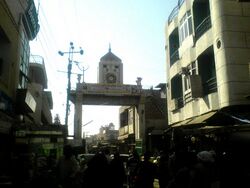
Sudkain Kalan Ahirka, Alewa, Amarheri, Anoopgarh, Ashrafgarh, Assan, Badhana, Baganwala, Bahbalpur, Barar Khera, Barodi, Baroli, Barsana Jind, Barsola, Bharon Khera, Bibipur, Bighana, Birbaraban, Bishanpura, Bohat Wala, Brah Kalan, Brah Khurd, Buwana, Chabri, Chuharpur, Dalamwala, Danda Kheri, Darya Wala, Dauhla, Dhigana, Dhillowal, Durana, Ghimana, Gobindpura, Gohian, Gunkali, Haibatpur, Hassanpur, Igra, Ikas, Intal Kalan, Intal Khurd, Jajwan, Jalalpur Kalan, Jalalpura Khurd, Jhanj Kalan, Jhanj Khurd, Jind (M Cl), Jitgarh, Jiwanpur, Julani, Kachrana Kalan, Kachrana Khurd, Kaer Kheri, Kandela, Katwal, Khanda, Kharak Ramji, Kheri Bulanwali, Kheri Naguran, Kheri Taloda, Khima Kheri, Khokhri, Khunga, Kinana, Kishanpura, Lakhmir Wala, Lalit Khera, Lohchab, Mando Kheri, Manohar Pur, Naguran, Nidana, Nidani, Nirjan, Padana, Pegan, Pindara, Ponkar Kheri, Radhana, Raichandwala, Rajpura, Ramgarh, Ramkali, Ramrai, Roopgarh, Sandil, Sangatpura, Sewaha, Shahpur, Shamdo, Shamlo Kalan, Shamlo Khurd, Sindhvi Khera, Sirirag, Taloda, Teg Bahadurpur, Thuha,
Myth about Jind
There is a myth about Jind. Its believed to be Jayant Nagari as described in the ancient literature.It is believed that its name has originated from Jayant who was the son of Indra(God of weathers). According to another legend, the Pandavas built here a temple in honor of Jainti Devi (the goddess of victory) and offered prayers for success in their battle against the Kauravas. The town grew up around the temple and was named Jaintapuri, (abode of Jainti Devi) which in course of time corrupted to Jind. Pandavas offered prayers to the goddess to seek her blessings for success before launching the Battle of Mahabharata. The authenticity of the fact can be ascertained from the Mahabharata and the Padam Purana, Jind forms part of the Kurukshetra Bhumi i.e. divine land of 48 Kosa. That is why, unlike in other cities, the mortal remains of those who die in Jind are not taken to Haridwar for immersion in the Holy Ganges but are immersed in Jind itself in some holy pond or canal.
Jayanta in Mahabharata
Virata Parva, Mahabharata/ Book IV Chapter 5 mentions that when Pandavas spent their last year in exile in the Kingdom of Virata, they changed their names. One of them was called Jayanta (Mahabharata: IV.5.30). For purposes of non-discovery Yudhisthira kept these (five) names for himself and his brothers respectively, viz., Jaya, Jayanta, Vijaya, Jayatsena, and Jayatvala. Then they entered the great city, with the view to passing the thirteenth year undiscovered in that kingdom, agreeably to the promise (to Duryodhana)."
Virata Parva, Mahabharata/ Book IV Chapter 5 helps us to identify the location of the Kingdom of exile. It mentions that those heroes proceeded in the direction of the river Yamuna. And those bowmen desirous of (speedily) recovering their kingdom, hitherto living in inaccessible hills and forest fastnesses, now terminated their forest-life and proceeded to the southern bank of that river. And those mighty warriors endued with great strength and hitherto leading the lives of hunters by killing the deer of the forest, passed through Yakrilloma and Surasena, leaving behind, on their right, the country of the Panchalas, and on their left, that of the Dasharnas. And those bowmen, looking wan and wearing beards and equipped with swords, entered Matsya's dominions leaving the forest, giving themselves out as hunters. And on arriving at that country, Krishna addressed Yudhishthira, saying, 'We see footpaths here, and various fields. From this it appears that Virata's metropolis is still at a distance. Pass we here what part of the night is still left, for great is my fatigue."
जींद
विजयेन्द्र कुमार माथुर[5] ने लेख किया है ... जींद (AS, p.366) (हरयाणा) पटियाला के निकट भूतपूर्व जाट सिख रियासत थी. कहा जाता है इस नगर का प्राचीन नाम जयंती था जो जयंतीदेवी के मंदिर के कारण हुआ था. प्राचीन भूतेश्वर महादेव का मंदिर सूर्यकुण्ड नामक सरोवर के मध्य में स्थित है और समीप ही जयंतीदेवी का मंदिर है. भूतेश्वर मंदिर का जीर्णोद्धार महाराजा रघुवीर सिंह ने करवाया था.
जींद परिचय

जींद शहर, उत्तर मध्य हरियाणा राज्य, पश्चिमोत्तर भारत में स्थित है। जींद शहर ऐतिहासिक एवं धार्मिक दृष्टि से अत्यन्त महत्त्वपूर्ण है।
इतिहास: जींद के बारे में मान्यता है कि इसकी स्थापना महाभारत महाकाव्य के पांडवों ने की थी, जिन्होंने यहाँ एक मंदिर बनवाया था, जिसके इर्द-गिर्द जींद (जैंतपुरी) नगर बसा था। जींद पहले 18वीं शताब्दी में एक जाट सिख सरदार द्वारा स्थापित पंजाब के फुलकियाँ रजवाड़ों में से एक था।
यहाँ पर स्थित सुविख्यात जयन्ती देवी मंदिर के नाम से इस नगर का नाम जींद पड़ा है। पांडवों ने महाभारत का युद्ध लड़ने से पहले अपनी सफलता के लिए 'विजय देवी-जयन्ती देवी' मंदिर का निर्माण करके श्रद्धापूर्वक देवी की आराधना की। जयन्ती देवी की आराधना के बाद ही पांडवों ने कौरवों के विरुद्ध सत्य समर्पित महासंग्राम किया, जो महाभारत के रूप में विश्वविख्यात हुआ।
संदर्भ: भारतकोश-जींद
सिद्धू - बराड़ जाटवंश
दलीप सिंह अहलावत [6] के अनुसार ये दोनों जाटवंश (गोत्र) चन्द्रवंशी मालव या मल्ल जाटवंश के शाखा गोत्र हैं। मालव जाटों का शक्तिशाली राज्य रामायणकाल में था और महाभारतकाल में इस वंश के जाटों के अलग-अलग दो राज्य, उत्तरी भारत में मल्लराष्ट्र तथा दक्षिण में मल्लदेश थे। सिकन्दर के आक्रमण के समय पंजाब में इनकी विशेष शक्ति थी। मध्यभारत में अवन्ति प्रदेश पर इन जाटों का राज्य होने के कारण उस प्रदेश का नाम मालवा पड़ा। इसी तरह पंजाब में मालव जाटों के नाम पर भटिण्डा, फरीदकोट, फिरोजपुर, लुधियाना आदि के बीच के प्रदेश का नाम मालवा पड़ा। (देखो, तृतीय अध्याय, मल्ल या मालव, प्रकरण)।
जब सातवीं शताब्दी में भारतवर्ष में राजपूत संघ बना तब मालव या मलोई गोत्र के जाटों के भटिण्डा में भट्टी राजपूतों से भयंकर युद्ध हुए। उनको पराजित करके इन जाटों ने वहां पर अपना अधिकार किया। इसी वंश के राव सिद्ध भटिण्डा नामक भूमि पर शासन करते-करते मध्य भारत के सागर जिले में आक्रान्ता होकर पहुंचे। इन्होंने वहां बहमनीवंश के फिरोजखां मुस्लिम शासक को ठीक समय पर सहायता करके अपना साथी बना लिया था जिसका कृतज्ञतापूर्वक उल्लेख शमशुद्दीन बहमनी ने किया है। इस लेखक ने राव सिद्ध को सागर का शासनकर्त्ता सिद्ध किया है। राव सिद्ध मालव गोत्र के जाट थे तथा राव उनकी उपाधि थी। इनके छः पुत्रों से पंजाब के असंख्य सिद्धवंशज जाटों का उल्लेख मिलता है। राव सिद्ध अपने ईश्वर विश्वास और शान्तिप्रियता के लिए विख्यात माने जाते हैं। राव सिद्ध से चलने वाला वंश ‘सिद्धू’ और उनकी आठवीं पीढ़ी में होने वाले सिद्धू जाट गोत्री राव बराड़ से ‘बराड़’ नाम पर इन लोगों की प्रसिद्धि हुई। राव बराड़ के बड़े पुत्र राव दुल या ढुल बराड़ के वंशजों ने फरीदकोट और राव बराड़ के दूसरे पुत्र राव पौड़ के वंशजों ने पटियाला, जींद, नाभा नामक राज्यों की स्थापना की। जब पंजाब पर मिसलों का शासन हुआ तब राव पौड़ के वंश में राव फूल के नाम पर इस वंश समुदाय को ‘फुलकिया’ नाम से प्रसिद्ध किया गया। पटियाला, जींद, नाभा रियासतें भी फुलकिया राज्य कहलाईं। बाबा आला सिंह संस्थापक राज्य पटियाला इस वंश में अत्यन्त प्रतापी महापुरुष हुए। राव फूल के छः पुत्र थे जिनके नाम ये हैं - 1. तिलोक 2. रामा 3. रुधू 4. झण्डू 5. चुनू 6. तखतमल। इनके वंशजों ने अनेक राज्य पंजाब में स्थापित किए।
जाट वीरों का इतिहास: दलीप सिंह अहलावत, पृष्ठान्त-774
फुलकिया से सम्बन्धित कैथल और अरनौली राज्य थे। इनके अतिरिक्त भदौड़, झुनवा, अटारी आदि छोटी-छोटी रियासतें भी सिद्धू जाटों की थीं। यही वंश पंजाब में सर्वाधिक प्रतापी है और सम्पूर्णतया धर्म से सिक्ख है।
राव सिद्धू के पुत्र राव भूर बड़े साहसी वीर योद्धा थे। अपने क्षेत्र के भट्टी राजपूतों से इसने कई युद्ध किए। इसी तरह से राव भूर से सातवीं पीढ़ी तक के इस सिद्धूवंश के वीर जाटों ने भट्टी राजपूतों से अनेक युद्ध किए। भट्टी राजपूत नहीं चाहते थे कि हमारे रहते यहां कोई जाट राज्य जमे या जाट हमसे अधिक प्रभावशाली बनकर रहें किन्तु राव सिद्धू की आठवीं पीढ़ी में सिद्धू गोत्र का जाट राव बराड़ इतना लड़ाकू शूरवीर, सौभाग्यशाली योद्धा सिद्ध हुआ कि उसने अपनी विजयों द्वारा राज्यलक्ष्मी को अपनी परम्परा में स्थिर होने का सुयश प्राप्त किया। यहां तक कि फक्करसर, कोट लद्दू और लहड़ी नामक स्थानों पर विजय प्राप्त करने पर तो यह दूर-दूर तक प्रख्यात हो गया। राव बराड़ के नाम पर सिद्धूवंशज बराड़वंशी कहलाने लगे। आजकल के सिद्धू जाट अपने को बराड़वंशी कहलाने में गौरव अनुभव करते हैं। इस वीर योद्धा राव बराड़ के दो पुत्र थे। बड़े का नाम राव दुल (ढुल) और छोटे का नाम राव पौड़ था।
इन दोनों की वंशपरम्परा में पंजाब में निम्न राज्य स्थापित किए ।
History of Jind
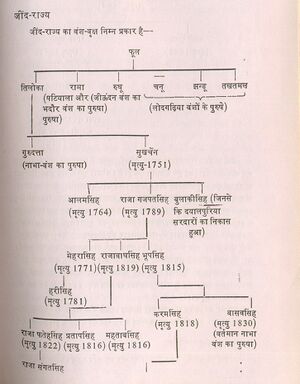
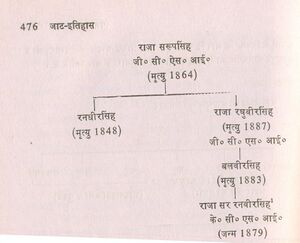
V. S. Agrawala[7] writes that Patanjali mentions names of two other janapadas, viz., Rishika and Jihnu. Rishika - The Rishika occurs in Mahabharata as part of Sakadvipa, Arjuna conquered Rishikas across the Vakshu (Oxus), which flowed through the Saka country. Rishikas were later known as Yuechis, whose language was called Ārśi. Jihnu is perhaps modern Jhind.
THE Raja of Jind is of the same family as the Maharaja of Patiala, being like him, descended from Choudhari Phul[8].
The Originator of the Phulkian Dynasty, Phul left six sons, of whom Tiloka was the eldest, and from him are descended the families of Jind and Nabha.[9]
From Rama, the second son, sprang the greatest of the Phulkian houses, that of Patiala besides Bhadaur, Kot Duna and Malaudh .[10]
In 1627 Phul founded and gave his name to a village which was an important town in the State of Nabha. His two elder sons founded Bhai Rupa while Rama also built Rampura Phul.
Jat history reveals that Jind was founded by descendants of Phool Jat. Jind was a native state in Haryana. Jind was a state of Siddhu Jats founded by grandson of Chaudhary Phul Singh who had six sons namely, 1.Tiloka 2.Ram Singh 3.Rudh 4.Chunu 5. Jhandu and 6.Takhtmal. Area of the state was 1259 sq mile and annual income of Jind state was Rs 30,00,000/-.
Claiming descent from Jaisal, founder of the State of Jaisalmer in 1156, the founder of this Sikh dynasty, Phul, was Chaudhary (Governor) of a country located at the south east of Dihli. Phul’s descendants founded 3 States: Patiala, Jind and Nabha.
Tiloka had two sons namely, 1. Gurudutta 2. Sukh Chain. Sukh Chain's decendants ruled Jind state and Gurudatta's descendants ruled Nabha state.
Jind is noted for its numerous temples sacred to the worship of Shiva. Tradition assigns the settlement of the town to the Mahabharat period.
Raja Gajpat Singh in 1755 seized a large tract of country including the present districts of Jind from the Afghan and made Jind the capital of the state in 1776. He made a fort here in 1775. Later, Sangrur was chosen as capital of Jind State by Raja Sangat Singh (1822 to 1834 AD).
Jat Monuments
Location-zafargarh fort located in kilazafargarh village in jind distt.this village belong to sehrawat jat gotra
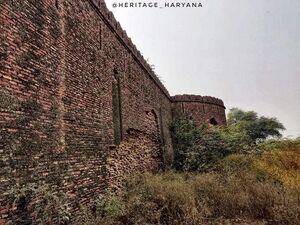
Jafargarh Fort, built by the Sidhu Jat rulers of the princely state of Jind. It was built in 1854, due to the non-maintenance of the royal family and the Haryana government, this fort has turned into a block today. This fort has been built from the inside, most of the Jat heritage has already been finished or is in its final stages! Pictures credit:- Haryana Heritage page.[11]
The origin of the family of Jhind
Lepel H. Griffin writes: [12]
Until the time of Chaudhri Phul (Sidhu - Jat clan), the history of the Pattiala and the Jhind families are the same, and there is no occasion to repeat here what has already been recorded regarding it.* (See:The Rajas of the Punjab by Lepel H. Griffin/The History of the Patiala State)
Tilokha, the eldest son of Phul, had two sons, Gurditta and Sukhchen, from the elder of whom has descended the Nabha family, and from the younger the Chiefs of Jhind, Badrukhan and Bazidpur. Tilokha succeeded his father as Chaudhri, but although he thus became the head of the family, he was not a man of any energy, and made no attempt to increase his share of the estate. Sukhchen, the second son, was a simple zamindar, and nothing worthy of record is known of him, except his marriage to Agan, the daughter of Chuhr Singh, a Bhullar Jat of Mandi, who bore him three sons, Alam Singh, Gajpat Singh and Bulaki Singh. He founded several new villages, one of which, called after his own name, he gave to his youngest son Bulaki Singh ; and a second, Balanwali, to Alam Singh. After having made his division of his estate, he continued to reside with his second son Gajpat Singh, at the ancestral village of Phul, where he died, aged seventy-five, in the year 1758.
* Anie, pp. 2-9
The following is the genealogy of the Jhind family (as pictured).
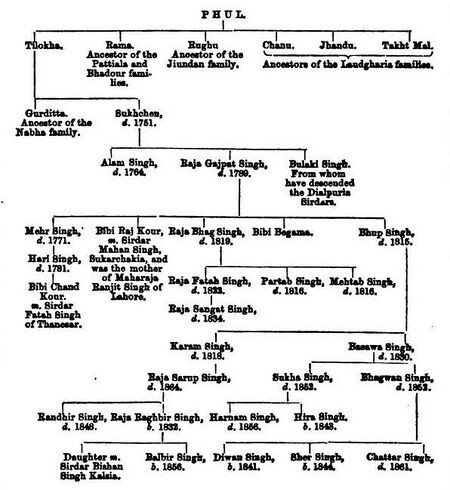
It is with Gajpat Singh that Jhind history is specially concerned, and the briefest notice is required of the other sons of Sukhchen.
Alam Singh, the eldest son of Sukhchen
Alam Singh, the eldest, was a brave soldier, and distinguished himself in many fights With the Imperial troops.
After the conquest of Sirhind, in 1763, he took possession of a considerable tract of country, but was killed the following year by a fall from his
horse. He left no children, though he had married three times. His first wife was of a Gill family of Cholia Chubara, his second the daughter of Man zamindar of Maur Saboki, and the last a girl, Mala by name, whom he had induced to elope from the house of her Either a Dhaliwal zamindar.
Bulaki Singh, the youngest son of Sukhchen, was the ancestor of the Dialpuria Sirdars, of whom a notice has been already given in the chapter on the Minor Phulkian Houses.* He died in 1785.
Gajpat Singh, the " second son, was born about the year 1783 and grow up a fine handsome youth, well skilled in all military exercises. He lived with his father at Phul, till the latter's death, assisting him against his rival and brother Gurditta, in whose time commenced the feud between the Jhind and Nabha houses, which is even now hardly healed. The great subject of dispute was the possession of Rampura Phul, the ancestral village, which each branch of the family naturally desired to own, and to which Chaudhri Gurditta's claims, as head of the Phulkian house, were perhaps the stronger. It was at the instigation of Gurditta, that, in 1743, when Gajpat Singh was five years old, both he and his mother Agan were captured by the Imperial troops and carried prisoners to Dehli as hostages for Sukhchen, who had fallen into arrears with his revenue collections, and who contrived to escape the troops sent to seize him. The mother and child were fortunate enough to soon escape through the fidelity and courage of one
* Vide ante p. 307.
of Agan's slave girls, who disguised her mistress in her own dress and remained behind in her place in the prison.
The family of Gajpat Singh
Gajpat Singh married, in 1754, one of the widows of his brother Alam Singh, and succeeded to his estate of Balawali. This wife bore him one daughter, Begama. Previous to this he had married the daughter of Kishan Singh of Monshia, of whom were born four children, Mehr Singh, Bhag Singh, Bhup Singh, and a daughter Raj Kour, who was married to Sirdar Mahan Singh Sukarchakia and became the mother of Maharaja Ranjit Singh of Lahore.
His conquests and misfortunes:
Gajpat Singh joined the Sikh army in 1768, when Zin Khan the Afghan Governor of Sirhind was defeated and slain ; and he then seized a large tract of country, including the districts of Jhind and Safidon, overrunning Panipat and Karnal, but he was not sufficiently strong to hold them. Yet, in spite of this rebellion, he did not deny altogether the authority of the Dehli Court. He remained, as before, a Malguzdr of Dehli, paying revenue to the Emperors; and, in 1767, having fallen a lakh and a half into arrears, he was taken prisoner by Najib Khan, the Muhammadan Governor, and carried to Dehli, where he remained a prisoner for three years, only obtaining release by leaving his son, Mehr Singh, as a hostage for the punctual payment of what was due. He then returned to Jhind, where, after great difficulties and delay, collecting three lakhs of Rupees he carried them to Dehli and not only freed his son, but obtained the title
He obtains the title of Raja AD 1768:
of Raja, under a Royal Firman or grant.* From this time Gajpat Singh assumed the style of an independent prince, and coined money in his own capital.
The marriage of Raj Kor to Sirdar Mahan Singh:
In 1774, the marriage of Sirdar Mahan Singh Sukarchakia was celebrated with Raj Kour, the daughter of Raja Gajpat Singh, at Bhadra Khan, then the capital of Jhind. The Gujranwala Chief came with a large retinue, and all the Phulkian Chiefs were assembled in honor of the occasion. A trifling incident which occurred during the festivities was the cause of a serious quarrel between Nabha and Jhind. The Sirdar of the former State, Hamir Singh, had a valuable grass preserve or "Bir" in the neighbourhood of Bhadra Khan, in which the Baratis or attendants of the bridegroom, were permitted to cut grass for their horses. But no
sooner had they commenced operations than Yakub Khan, the Agent of Hamir Singh, more zealous than hospitable, attacked them and a fight was the result, of which no notice was taken till after ceremony and departure of the bridegroom. [Page-315] tory, and attacked Sangrur, which was defended for four months by Sirdarni Deso, wife of Hamir Singh. At length, seeing her cause desperate, she begged the Raja of Pattiala to interfere. This Chief, who had encourage, the attack in the first place, hoping to weaken both Jhind and Nabha and consequently increase his own power, had no wish to see the former become too powerful, and interposed with other Sikh Sirdars, compelling Raja Gajpat Singh to restore Imloh and Bhadson and release Hamir Singh. Sangrur was retained and has ever since been included in the Jhind territory.
Jhind attacked by the Governor of Dehli:
The next year Rahim Dad Khan, Governor of by Hansi, was sent against Jhind by the Dehli Governor Nawab Majad-ul-dowla Abdulahd Khan, and Raja Bhag Singh summoned to his assistance the Phulkian Chiefs.
History in Hindi
Read more about History of Jind by Thakur Deshraj in Hindi
George Thomas attacks the town of Jhind
Lepel H. Griffin writes:[13]George Thomas, unable to cajole the Sikhs, determined on subduing them, and taking advantage of the absence of the principal Chiefs at Lahore, in 1798, to oppose the invasion of Shah Zaman Durani of Kabul, he laid siege to Jhind, the nearest Sikh town, being not more than twenty miles north-east of Hansi. Hearing of this danger the Phulkian Chiefs hurried back and assembled their forces for the relief of Jhind. The Kythal troops were under the command of Sirdars Sawan Singh, Saman Singh and Diwan Ramdyal ; while Gurdit Singh of Ladwa and the Thanesar Chiefs, Bhanga Singh and Mehtab Singh, were induced to join by considerable presents. They had not yet fallen so low as to fight for honor or for a friend, without the hope of some personal gain.
Jat Gotras in Jind District
Bedian, Bhanwala, Binner, Bura, Dalal, Deswal, Dhall, Dhanda, Dhankhar, Dhull; Gangas, Goyat, Kanchap, Khatkar, Kundu, Lather, Lohach Lohan, Malik, Mor, Naidu, Nain, Kandola, Pahal, Pahil, Pannu, Phour, Phore, Punia, Rad, Randhawa Raparya, Rathi, Ravish, Redhu,Sehrawat, Sheokand, Shokeen, Shoor, Sihmar
Notable persons
External Links
Gallery
-
Maharaja Ranbir Singh of Jind,
-
H.H Maharaja Ranbir Singhji of Jind along with H.H Maharaja Jagatjit Singh of Kapurthala.
-
Clock Tower: The grand clock tower was commissioned in 1885 by Maharaja Raghubir Singh of Jind from the Canal Foundry Roorkee. The current caretaker of this working clock tower is Sampat Rai Walia, whose family has been taking care of the clock tower in the town since its installation in 1885 by the then Jind royals. This clock lies in a fairly good state and could be counted as a point of interest during heritage trails.
-
Kunwar Zorawar Sher Singh of Kalsia with H.H. Maharaja Satbir Singh, Maharaja of Jind
-
Maharajkumari Jagatbir Kaur of Jind( Princess Beryl) daughter of Maharaja Ranbir Singh of Jind and his wife Maharaja Gurcharan Kaur. She married the Maharajkumar of Tikari. State:- Jind, Dynasty :- Sidhu Jat. Credit:- Shahla Tikari
-
H.H. Maharaja Rajbir Singhji, Maharaja Of Jind with Royal Procession Nabha Gate, Sangrur.Source - Jat Kshatriya Culture
-
Maharaja Gajpat Singh of Jind, Maternal Grandfather of Sandhawalia Jat Ruler Maharaja Ranjit Singh of Lahore.
-
Maharaja Yadavindra Singh of Patiala, Maharaja Ranbir Singh Of Jind, Maharaja Jagatjit Singh of Kapurthala Maharaja Pratap Singh of Nabha, Maharaja Sir Harinder Singh Brar of Faridkot with Sardar Vallabhai Patel
-
H.H Maharaja Sri Sir Ranbir Singh of Jind with Colonel Bernard Ramsden James.
References
- ↑ Aitihasik Sthanavali by Vijayendra Kumar Mathur, p.356
- ↑ Mahipal Arya, Jat Jyoti, August 2013,p. 15
- ↑ V. S. Agrawala: India as Known to Panini, 1953, p.62
- ↑ V. S. Agrawala: India as Known to Panini, 1953, p.62
- ↑ Aitihasik Sthanavali by Vijayendra Kumar Mathur, p.366
- ↑ Jat History Dalip Singh Ahlawat/Chapter IX, pp. 774-775
- ↑ V. S. Agrawala: India as Known to Panini, 1953, p.62
- ↑ An historical sketch of the native states of India/The Cis-Satlaj states, by Malleson, G. B., p.337
- ↑ Latif, S.M., History of the Punjab
- ↑ A collection of treaties, engagements, and sunnuds, relating to India By India Foreign and Political Dept, Charles pp.274
- ↑ Jat Kshatriya Culture
- ↑ The Rajas of the Punjab by Lepel H. Griffin/The History of the Jhind State, pp.
- ↑ The Rajas of the Punjab by Lepel H. Griffin/The History of the Patiala State, p.82
- Jat Villages
- Jat Villages in Haryana
- Villages in Jind
- Ancient Jat Villages
- Jat History
- Jat History in Haryana
- Haryana Districts
- Jat States
- Ancient Jat Villages in Haryana
- Genealogy
- Mahabharata People
- Mahabharata People and Places
- People and Places by Panini
- General History
- AS
- AS Haryana
- Jat Forts
- Jat Forts in Haryana
- Jat Forts in Jind










